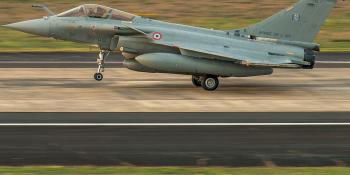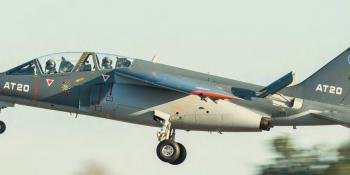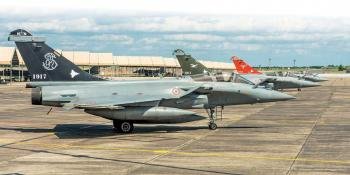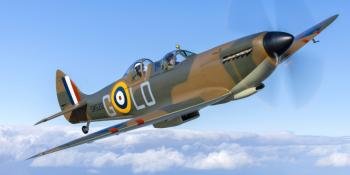FRANCE

ON OCTOBER 12, several French press outlets reported on a first successful trial to aerial refuel Armée de l’Air Caracals assigned to Escadron d’Hélicoptères (EH) 1/67 ‘Pyrénées’, from an Ejército del Aire KC-130 Hercules. The trial is reported to have taken place near BA125 Istres in southern France. Supposedly, this first trial only included daytime runs, but future trials should also involve nighttime refuelling.
The French are keen to develop their aerial refuelling capabilities with NATO partners deployed to the same theatres. The Armée de l’Air currently trains at least twice a year with the Air Force Special Operations Command during the Dark Dune series of exercises, but also teams up with US Air Force HC-130s and MC-130s during other exercises, such as this year’s Emerald Warrior in Florida. The French conducted regular aerial refuelling exercises with Aeronautica Militare KC-130Js from 46° Brigata Aerea based at Pisa in the past, but these have not taken place since the HH-101 came into service with the Aeronautica Militare. The Ejército del Aire C-130 Hercules fleet is based at Zaragoza, which is relatively close to EH 1/67’s base at BA120 Cazaux. Furthermore, the Spanish are often deployed to the Sahel and are involved with the United Nations Multidimensional Integrated Stabilization Mission in Mali and Opération Barkhane. If the Caracals are deployed in the region, there is a good chance that Ejército del Aire KC-130s and EC725s will be in the same zone. If a US Air Force aerial refuelling platform is not available (the first Armée de l’Air KC-130J is still a few years away from being operational), the Spanish KC-130 would be a valuable platform for the French Special Forces missions in the Sahel.
The French have been developing the Caracal as a platform more adapted for special ops. Just before the summer, EH 1/67 received the first Nexter SH20 cannons. After almost ten years of planning and testing, the 20mm cannon can now be used for missions involving close air support or increased defensive capability. Average firing rate of the SH20 is 750 rounds per minute, the effective range is up to 2km (1.24 miles) and the system has three firing modes: single shot, limited and unlimited bursts fed from cases of 240 rounds. A Caracal was reported by French media to have flown with two ammunition cases during a recent exercise that saw qualification of the first gunners. The French MoD had planned to buy approximately 15 SH20s. Ten should equip the Aviation Légère de l’Armée de Terre’s Cougar Rénové fleet operated by the 5th Regiment based at Pau, and five should be divided between the Caracals assigned to the Aviation Légère de l’Armée de Terre’s 4th Special Forces Helicopter Regiment, and those belonging to EH1/67.

Atlantique 2 and Opération Chammal
September 19 marked the fourth anniversary of the start of Opération Chammal, during which time French armed forces have flown 8,477 sorties, conducted 1,457 airstrikes, and destroyed 2,249 targets.

One aircraft type that has been involved in Opération Chammal on an almost continuous basis is the Atlantique 2. Originally developed as a submarine hunter, today the Atlantique 2 can be best described as a Swiss Army knife in its current role. During Chammal missions, the Atlantique 2 is often used as an intelligence, surveillance and reconnaissance platform. Besides the pilots and two flight engineers, the crew also includes a tactical commander, a Joint Terminal Attack Controller and nine operators specialising in electronic warfare, air traffic control and acoustics.
During Chammal missions, Atlantique 2s conduct everything from taking and interpreting images, identifying and following targets, relaying data and messages, detecting radars and other signals to designating targets for other aircraft or dropping bombs from the bomb bay.
Using a Wescam MX-series multispectral sensor, the Atlantique 2 crew can detect, identify and follow a target, send highdefinition images or video directly to the command centre and, thanks to the available fuel load, can stay on station to carry out possible strikes and/or perform a battle damage assessment, all during a single mission.
First this, first that
In the last week of September, an A400M assigned to Escadron de Transport (ET) 1/61 ‘Touraine’ dropped approximately 80 paratroopers over Mali, an operational first for the type. Since the A400M cannot yet drop paratroopers from its aft-side doors with the use of a static line, the 80 paratroopers had to jump from the main ramp.
The Armée de l’Air’s other new aircraft, the C-130J, also achieved a first in September. The aircraft and personnel from the Centre d’Expertise Aérienne Militaire and ET 2/61 ‘Franche Comté’ deployed to Gao and Tessalit in Mali between September 10 and 19, to perform tests on softer compound, unpaved runways as part of its tactical qualifications in the buildup to operational service. Earlier this year, the C-130J underwent tests on harder unpaved surfaces in Djibouti. During the September deployment, the Hercules transported 560 troops and almost 60 tonnes of freight in under 40 flying hours. According to the Armée de l’Air, the C-130J should be operational in the spring of next year.

Elsewhere, the Aviation légère de l’Armée de Terre reported it would deploy a fifth NH90 to Opération Barkhane. The service has received additional airframes this year and the type is now slowly taking over from the venerable Puma. Although the Puma is cheaper to operate in the harsh environments of the Sahel, the NH90 can transport more troops, making it an appealing aircraft to the French forces that have to travel large distances during operations.
The first Armée de l’Air A330 MRTT Phénix 041 arrived at BA125 Istres on September 27. Minister of the Armed Forces Florence Parly was expected to visit Istres on October 19 for an official ceremony. The Armée de l’Air expects to receive the first 12 of its 15 planned Phénix aircraft by 2023, replacing both types of KC- 135 tanker assigned to Groupe de Ravitaillement en Vol (GRV) 2/91 ‘Bretagne’, the A310 and A340 transport aircraft, operated by ET 3/60 ‘Estérel’. Phénix is expected to be declared operational some time in 2019, and the second Armée de l’Air aircraft made its first flight on the same day that the first aircraft arrived at Istres.
An Armée de l’Air MQ-9 Reaper operated by Escadron de Drones 1/33 ‘Belfort’ participated in the NATO Tactical Leadership Program course 2018-3 in the week of October 2, the second time a French Reaper had flown over Spain. In September, an Armée de l’Air MQ-9 first flew into Spanish air space to designate targets for Ejército del Aire fighter aircraft. The Armée de l’Air operates five of its six Block 1 Reapers from Niamey in Niger, whereas the sixth aircraft is based at BA709 Cognac. Six more Reapers are currently on order.








